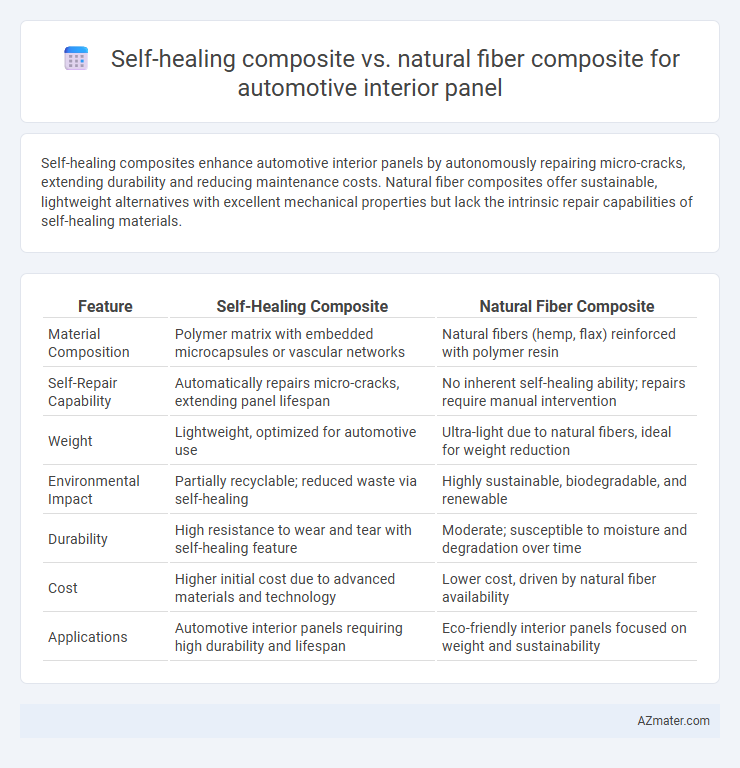Self-healing composites enhance automotive interior panels by autonomously repairing micro-cracks, extending durability and reducing maintenance costs. Natural fiber composites offer sustainable, lightweight alternatives with excellent mechanical properties but lack the intrinsic repair capabilities of self-healing materials.
Table of Comparison
| Feature | Self-Healing Composite | Natural Fiber Composite |
|---|---|---|
| Material Composition | Polymer matrix with embedded microcapsules or vascular networks | Natural fibers (hemp, flax) reinforced with polymer resin |
| Self-Repair Capability | Automatically repairs micro-cracks, extending panel lifespan | No inherent self-healing ability; repairs require manual intervention |
| Weight | Lightweight, optimized for automotive use | Ultra-light due to natural fibers, ideal for weight reduction |
| Environmental Impact | Partially recyclable; reduced waste via self-healing | Highly sustainable, biodegradable, and renewable |
| Durability | High resistance to wear and tear with self-healing feature | Moderate; susceptible to moisture and degradation over time |
| Cost | Higher initial cost due to advanced materials and technology | Lower cost, driven by natural fiber availability |
| Applications | Automotive interior panels requiring high durability and lifespan | Eco-friendly interior panels focused on weight and sustainability |
Introduction to Automotive Interior Panel Materials
Self-healing composites for automotive interior panels offer advanced damage-repair capabilities, extending material lifespan and reducing maintenance costs compared to natural fiber composites, which prioritize sustainability and lightweight characteristics. Natural fiber composites, derived from renewable resources like flax or hemp, contribute to eco-friendly interiors with reduced carbon footprint, though they may exhibit lower mechanical resilience than synthetic-based self-healing systems. Both materials represent crucial advancements in automotive engineering, balancing durability, environmental impact, and cost-effectiveness for interior panel applications.
Overview of Self-Healing Composites
Self-healing composites for automotive interior panels utilize embedded microcapsules or vascular networks containing healing agents that autonomously repair cracks and damage, enhancing durability and lifespan. These materials significantly reduce maintenance costs and improve safety by preserving structural integrity under mechanical stress. Compared to natural fiber composites, self-healing composites offer advanced functionality by mitigating micro-damage without human intervention, making them a cutting-edge solution for next-generation automotive interiors.
Natural Fiber Composites: Properties and Benefits
Natural fiber composites for automotive interior panels offer superior sustainability, lightweight characteristics, and excellent vibration damping compared to conventional materials. Their high strength-to-weight ratio enhances fuel efficiency while reducing vehicle emissions, and their biodegradability aligns with eco-friendly manufacturing goals. These composites also provide enhanced thermal insulation and reduce noise, improving passenger comfort within the vehicle cabin.
Comparative Mechanical Strength
Self-healing composites exhibit enhanced mechanical strength due to their ability to autonomously repair microcracks, extending the lifespan of automotive interior panels and reducing maintenance costs. Natural fiber composites, while offering lightweight and sustainable benefits, generally show lower tensile and impact resistance compared to self-healing counterparts, limiting their use in high-stress applications. Comparative studies reveal that self-healing composites maintain structural integrity under cyclic loading better than natural fiber composites, making them superior for durability-focused automotive interior components.
Durability and Lifespan Analysis
Self-healing composites for automotive interior panels exhibit enhanced durability through intrinsic crack repair mechanisms that significantly extend lifespan by preventing microstructural failures. In contrast, natural fiber composites, while offering eco-friendly and lightweight properties, generally present lower durability due to moisture absorption and fiber degradation over time, which can reduce structural integrity. Comparative lifespan analysis reveals self-healing composites maintain performance metrics longer under cyclic loading and environmental stress, making them superior for long-term automotive interior applications.
Impact on Vehicle Weight and Fuel Efficiency
Self-healing composites offer enhanced durability and damage recovery, reducing maintenance needs, while typically being lighter than traditional materials but heavier than natural fiber composites, potentially affecting vehicle weight and fuel efficiency. Natural fiber composites, made from flax, hemp, or jute, provide significant weight savings due to their low density, enhancing fuel efficiency by reducing overall vehicle mass. Choosing between these materials requires balancing the superior self-repair capabilities of self-healing composites with the lightweight and eco-friendly advantages of natural fiber composites for automotive interior panels.
Sustainability and Environmental Considerations
Self-healing composites in automotive interior panels reduce maintenance and extend product lifespan, minimizing resource consumption and waste generation compared to conventional materials. Natural fiber composites offer biodegradability and lower carbon footprint due to renewable raw materials, enhancing sustainability through reduced reliance on fossil fuels. Both materials contribute to environmental conservation, but natural fiber composites excel in end-of-life disposal while self-healing composites prioritize durability and lifecycle efficiency.
Cost-Effectiveness in Manufacturing
Self-healing composites offer enhanced durability and reduced maintenance costs for automotive interior panels but typically involve higher initial manufacturing expenses due to advanced materials and processing techniques. Natural fiber composites, sourced from renewable materials like hemp or flax, provide a cost-effective alternative with lower raw material and energy costs, aligning with sustainable production goals. While self-healing composites reduce long-term repair costs, natural fiber composites deliver immediate cost savings in manufacturing, making the choice dependent on the targeted balance between upfront investment and lifecycle cost efficiency.
Real-World Applications and Case Studies
Self-healing composites in automotive interior panels demonstrate enhanced durability by autonomously repairing micro-cracks, extending service life and reducing maintenance costs, as seen in case studies from leading manufacturers like BMW and Toyota. Natural fiber composites offer sustainable alternatives with lightweight properties and improved vibration damping, evidenced by their extensive use in Volkswagen's eco-friendly vehicle interiors. Real-world applications emphasize the trade-off between self-healing capabilities and environmental benefits, with a growing trend toward hybrid solutions integrating both technologies for optimized performance.
Future Trends in Automotive Interior Panels
Self-healing composites and natural fiber composites are shaping the future of automotive interior panels by enhancing durability and sustainability. Self-healing composites offer advanced damage resistance through embedded microcapsules that autonomously repair cracks, significantly extending panel lifespan and reducing maintenance costs. Meanwhile, natural fiber composites provide lightweight, eco-friendly alternatives with excellent mechanical properties, supporting the industry's shift towards greener materials and improved fuel efficiency.

Infographic: Self-healing composite vs Natural fiber composite for Automotive interior panel
 azmater.com
azmater.com